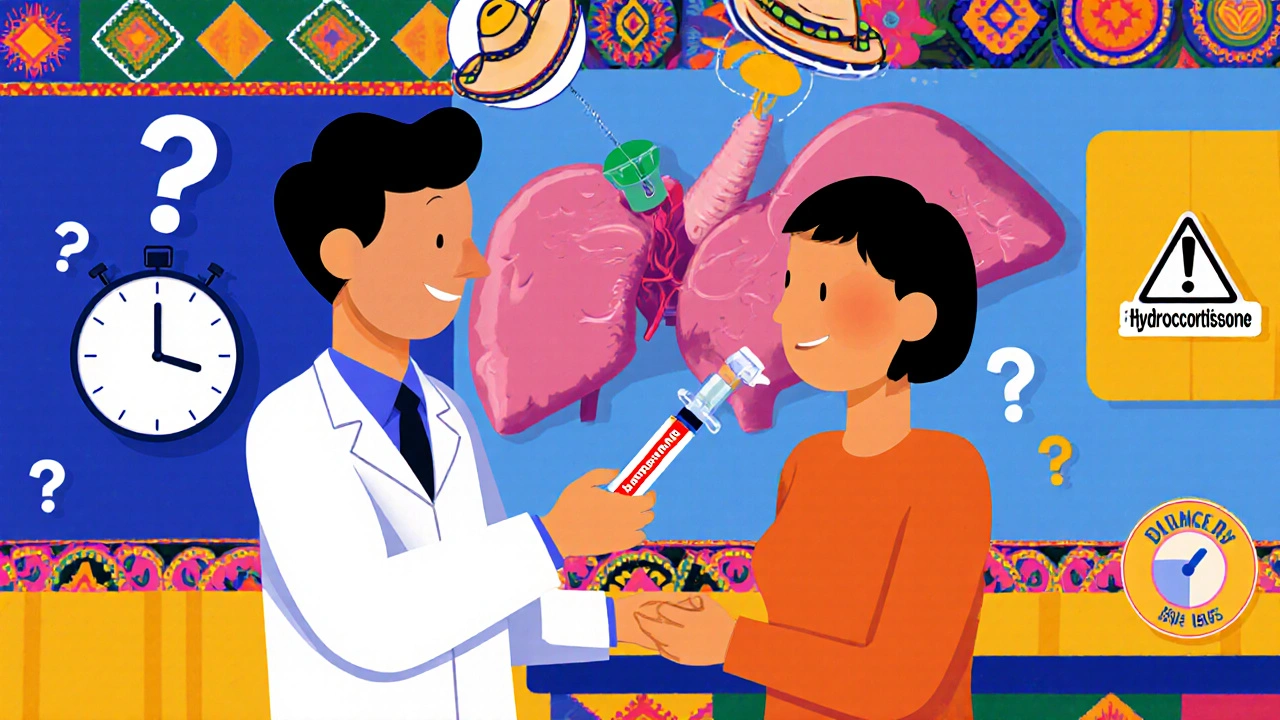Steroid Tapering Calculator
How to Use This Tool
This calculator determines your safe steroid tapering schedule based on your current dose and treatment duration. Always follow your doctor's specific instructions, but this tool provides a general guideline to discuss with your healthcare provider.
Stopping corticosteroids like prednisone suddenly can trigger a life-threatening condition called adrenal insufficiency. It doesn’t happen to everyone, but it’s far more common than most people realize-even after just a few weeks of use. If you’ve been on steroids for asthma, arthritis, or even a bad case of COVID-19, your body may have stopped making its own cortisol. When you stop the pills, your adrenal glands can’t snap back fast enough. That’s when symptoms hit: crushing fatigue, nausea, dizziness, and low blood pressure. Left untreated, it can lead to shock, coma, or death.
Why Your Body Stops Making Cortisol
Your adrenal glands sit on top of your kidneys and produce cortisol, the hormone your body needs to handle stress, regulate blood sugar, and keep your blood pressure stable. When you take synthetic corticosteroids-like prednisone, dexamethasone, or hydrocortisone-your brain thinks you’re already making enough. So it shuts down the signal (ACTH) that tells your adrenals to produce more. Over time, the glands shrink from lack of use. This is called HPA axis suppression.
For years, doctors thought you needed to be on high doses for months to risk this. But new data shows even low doses-like 5 mg of prednisone a day for four weeks-can cause suppression. A 2023 study in Endocrine Abstracts found that 30% of patients on short-term therapy still had blunted cortisol responses after stopping. That means if you quit cold turkey, your body has no backup plan.
What the Symptoms Look Like
Adrenal insufficiency doesn’t hit all at once. It creeps in over days. The first sign? Extreme tiredness that doesn’t go away with sleep. Then comes loss of appetite and weight loss. Nausea, vomiting, and muscle weakness follow. Many patients think they’re coming down with the flu-or worse, depression. A 2023 review of 85 patient reports found that 68% were initially misdiagnosed.
As it worsens, your blood pressure drops. You might feel lightheaded when standing. Your skin may darken slightly (a sign of high ACTH). If you’re vomiting and can’t keep fluids down, you’re heading toward an adrenal crisis. That’s when your body can’t handle even minor stress-like an infection or injury. Blood sugar crashes. You get confused. Your heart rate spikes. Without emergency treatment, you can go into shock.
One patient, a 45-year-old woman from Ohio, stopped dexamethasone after a COVID-19 infection. She thought her fatigue and nausea were lingering virus symptoms. Three weeks later, she collapsed at home. Her ER team found her cortisol level at 2.1 μg/dL-normal is 5-25. She was given IV hydrocortisone and improved within an hour.
Primary, Secondary, or Tertiary? Know the Difference
Not all adrenal insufficiency is the same. There are three types:
- Primary: The adrenal glands themselves are damaged (like in Addison’s disease).
- Secondary: The pituitary gland stops making ACTH.
- Tertiary: The hypothalamus stops making CRH, usually because of long-term steroid use.
Most cases from steroid withdrawal are tertiary. That’s important because testing differs. For primary insufficiency, you need an ACTH stimulation test. For tertiary, doctors often just check your morning cortisol level 24 hours after your last dose. If it’s below 5 μg/dL, you’re at high risk for withdrawal symptoms. Above 10 μg/dL? You’re likely fine.

Who’s at Risk-and When to Get Tested
Anyone who’s taken systemic steroids (pills, shots, IV) for more than 3-4 weeks is at risk. That includes people with:
- Asthma or COPD
- Rheumatoid arthritis or lupus
- Chronic skin conditions like eczema
- Organ transplants
- Post-COVID inflammation
The American Association of Clinical Endocrinologists says patients on more than 20 mg of prednisone daily for over 3 weeks should be tested before stopping. But here’s the problem: most primary care doctors don’t screen unless symptoms appear. And by then, it’s often too late.
That’s why experts now recommend that everyone prescribed steroids for more than 4 weeks gets written instructions about adrenal insufficiency. The NIDDK says this should happen at the start of treatment-not after you’ve already been taking it for months. Patients need to know the signs, when to call their doctor, and how to use an emergency injection.
How to Taper Safely
There’s no one-size-fits-all taper. But here’s what most guidelines agree on:
- For doses above 20 mg prednisone/day: Reduce by 2.5-5 mg every 3-7 days.
- For doses between 5-20 mg: Drop by 1-2.5 mg every 1-2 weeks.
- For doses under 5 mg or therapy longer than 6 months: Slow down. Reduce by 0.5-1 mg every 1-2 weeks.
Some patients need even slower tapers-especially if they’ve had adrenal crisis before, or if they’re under physical stress (like surgery or infection). The European Society of Endocrinology recommends 4-8 weeks for most, while the Endocrine Society says tailor it to the person. No protocol prevents all cases. But a slow taper cuts the risk dramatically.
One 2023 JAMA study found that 47% of patients skipped or rushed their taper because they were worried about side effects or couldn’t afford the meds. That’s dangerous. If you’re struggling to stick to the plan, talk to your doctor. There are often lower-cost generic options.

What to Do in an Emergency
If you’re feeling weak, nauseous, dizzy, and your blood pressure is low-especially after stopping steroids-assume it’s adrenal crisis until proven otherwise. Time is critical.
Emergency treatment is simple: 100 mg of hydrocortisone given intravenously right away, followed by 200 mg over 24 hours. Blood pressure usually improves within 30-60 minutes. Hospitals in the U.S. now follow Cleveland Clinic’s 2023 protocol for this. But if you’re not in a hospital, you need an emergency kit.
Patients who’ve been on long-term steroids should carry an emergency injection of hydrocortisone (like Solu-Cortef) and know how to use it. They should also wear a medical alert bracelet that says “Adrenal Insufficiency-Steroid Dependent.” A 2023 Mayo Clinic study showed that patients with these tools had 79% better outcomes.
One Reddit user, u/AdrenalWarrior, wrote: “My doctors kept saying it was post-viral fatigue. I didn’t know I needed to inject myself until I ended up in the ER. Now I carry it everywhere-even to the grocery store.”
What’s Changing in 2025
New tools are emerging to catch this before it’s too late. In 2024, researchers tested point-of-care cortisol devices that give results in 15 minutes-no lab needed. Three prototypes are in phase 2 trials. AI algorithms are also being trained to scan electronic records and flag patients at risk based on medication history, lab trends, and symptoms. One study hit 92% accuracy.
Genetic testing is coming too. A 2023 Nature Medicine study found seven gene variants linked to slower adrenal recovery. In the future, doctors may tailor tapers based on your DNA.
Meanwhile, the FDA and European Medicines Agency now require all systemic steroid packages to include a warning about adrenal insufficiency. Twenty-eight European countries have rolled out patient alert cards. In the U.S., the American Medical Association added adrenal crisis recognition to its 2024 continuing education requirements for doctors.
What You Can Do Today
If you’re on steroids:
- Don’t stop suddenly-no matter how good you feel.
- Ask your doctor for a written tapering plan before you start.
- Get a medical alert bracelet if you’ve been on steroids for more than 4 weeks.
- Carry an emergency hydrocortisone injection if you’re on more than 5 mg/day for over a month.
- Know the symptoms: fatigue, nausea, dizziness, low blood pressure.
- If you’re sick, injured, or stressed, double your dose-or call your doctor.
If you’re a caregiver or family member: Learn how to give the injection. It could save a life.
This isn’t about fear. It’s about awareness. Steroids save lives. But they come with a hidden risk-one that’s preventable with the right knowledge and preparation.
Can adrenal insufficiency happen after just a few weeks of steroids?
Yes. Even short-term use-like 4 weeks of 5 mg prednisone daily-can suppress your body’s natural cortisol production. A 2023 study in Endocrine Abstracts confirmed that adrenal suppression can occur after as little as 3 weeks of therapy, even at low doses.
How do I know if I’m having an adrenal crisis?
Signs include sudden severe fatigue, nausea, vomiting, dizziness, low blood pressure, confusion, or fainting-especially after stopping steroids. If you have these symptoms and recently stopped corticosteroids, treat it as an emergency. Call 911 or go to the ER immediately. Delaying treatment can be fatal.
Do I need to carry an emergency injection forever?
Not necessarily. Most patients regain normal adrenal function within 6-12 months after stopping steroids, but recovery varies. Your doctor can test your cortisol levels with an ACTH stimulation test to see if your adrenals are working again. Until then, especially if you’ve had a crisis before, carry the injection. Better safe than sorry.
Can I just reduce my dose faster if I feel fine?
No. Feeling fine doesn’t mean your adrenal glands have recovered. Cortisol production takes weeks to months to restart after suppression. Rushing the taper increases your risk of adrenal crisis. Stick to the plan your doctor gives you-even if you feel great.
Are there alternatives to steroids that don’t cause adrenal suppression?
For some conditions, yes. Biologics, immunomodulators, or inhaled steroids (for asthma) carry less systemic risk. But for autoimmune diseases or severe inflammation, steroids are often still the most effective option. The goal isn’t always to avoid them-it’s to use them wisely, taper properly, and be prepared for the risks.
What should I do if I miss a dose of steroids during my taper?
If you miss one dose, take it as soon as you remember-unless it’s close to your next scheduled dose. Don’t double up. If you miss multiple doses or are feeling unwell, contact your doctor immediately. You may need to temporarily increase your dose or get an emergency injection to avoid crisis.
Is adrenal insufficiency from steroids permanent?
Usually not. Most people recover full adrenal function within 6-12 months after stopping steroids. But recovery can take up to 18-24 months in some cases, especially after long-term, high-dose use. Regular follow-up with an endocrinologist and cortisol testing can confirm when your body is back to normal.


Written by Guy Boertje
View all posts by: Guy Boertje